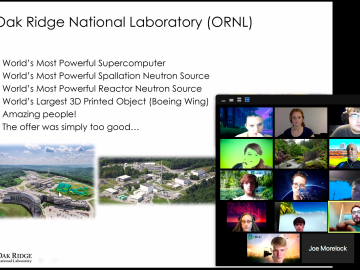
Filter News
Area of Research
- Advanced Manufacturing (2)
- Biological Systems (1)
- Biology and Environment (17)
- Clean Energy (58)
- Data (1)
- Fusion and Fission (5)
- Fusion Energy (1)
- Isotopes (4)
- Materials (33)
- Materials for Computing (2)
- National Security (7)
- Neutron Science (20)
- Nuclear Science and Technology (16)
- Quantum information Science (3)
- Supercomputing (29)
- Transportation Systems (1)
News Type
News Topics
- 3-D Printing/Advanced Manufacturing (18)
- Advanced Reactors (6)
- Artificial Intelligence (6)
- Big Data (10)
- Bioenergy (7)
- Biology (4)
- Biomedical (11)
- Biotechnology (1)
- Chemical Sciences (4)
- Clean Water (2)
- Climate Change (3)
- Computer Science (27)
- Coronavirus (12)
- Cybersecurity (3)
- Energy Storage (10)
- Environment (17)
- Exascale Computing (3)
- Fusion (11)
- Grid (3)
- High-Performance Computing (2)
- Isotopes (5)
- Machine Learning (3)
- Materials (2)
- Materials Science (19)
- Mathematics (2)
- Mercury (1)
- Microscopy (4)
- Molten Salt (1)
- Nanotechnology (9)
- National Security (2)
- Neutron Science (14)
- Nuclear Energy (21)
- Physics (11)
- Polymers (2)
- Quantum Science (8)
- Security (2)
- Space Exploration (1)
- Summit (7)
- Sustainable Energy (7)
- Transformational Challenge Reactor (3)
- Transportation (7)
Media Contacts

The Department of Energy has selected Oak Ridge National Laboratory to lead a collaboration charged with developing quantum technologies that will usher in a new era of innovation.

It’s a new type of nuclear reactor core. And the materials that will make it up are novel — products of Oak Ridge National Laboratory’s advanced materials and manufacturing technologies.

A team led by ORNL created a computational model of the proteins responsible for the transformation of mercury to toxic methylmercury, marking a step forward in understanding how the reaction occurs and how mercury cycles through the environment.

The Society of Manufacturing Engineers, known as SME, has named William Peter, director of Oak Ridge National Laboratory’s Manufacturing Demonstration Facility in the Energy and Environmental Sciences Directorate, among its 2020 College of SME Fellows.

As CASL ends and transitions to VERA Users Group, ORNL looks at the history of the program and its impact on the nuclear industry.

Scientists at the Department of Energy’s Oak Ridge National Laboratory have a powerful new tool in the quest to produce better plants for biofuels, bioproducts and agriculture.

Pick your poison. It can be deadly for good reasons such as protecting crops from harmful insects or fighting parasite infection as medicine — or for evil as a weapon for bioterrorism. Or, in extremely diluted amounts, it can be used to enhance beauty.

Each summer for the last 30 years, students and teachers from across Appalachia have travelled to ORNL for a unique STEM summer camp experience – the Appalachian Regional Commission/ORNL Science-Technology-Mathematics Institute.

Joe Hagerman, ORNL research lead for buildings integration and controls, understands the impact building technology innovations can have during times of crisis. Over a decade ago, he found himself in the middle of one of the most devastating natural disasters of the century, Hurricane Katrina.

Scientists seeking ways to improve a battery’s ability to hold a charge longer, using advanced materials that are safe, stable and efficient, have determined that the materials themselves are only part of the solution.


